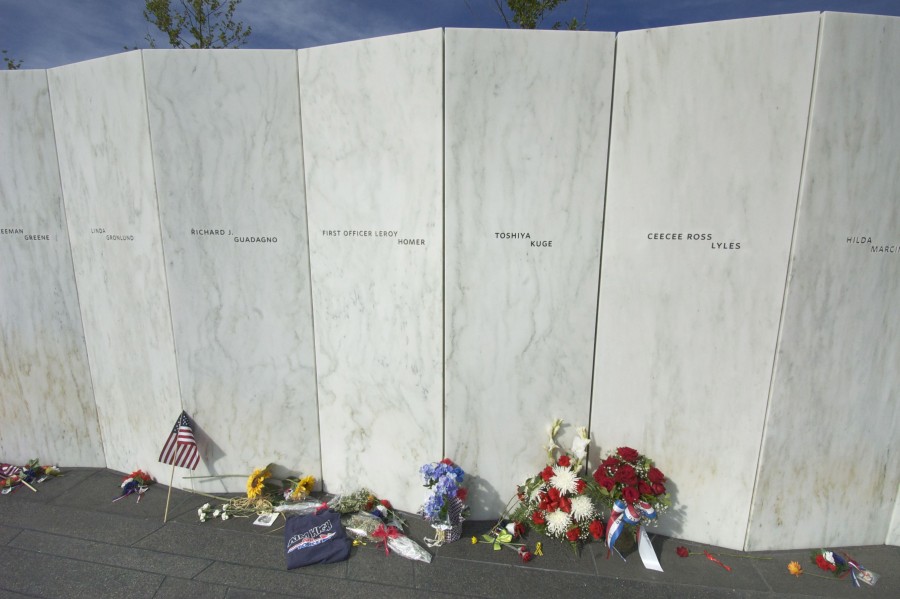By Lorri Drumm Pittsburgh Post-Gazette

The wall of names at the Flight 93 Memorial Anthony Conroy/Post-Gazette
What’s the best way to explain the horrors of the Flight 93 crash in Somerset County to school-age children?
A new approach is the “Junior Ranger Handbook,” officially released Saturday by the National Park Service at the Flight 93 National Memorial in Stonycreek. The parks service developed the 22-page booklet in collaboration with The Fred Rogers Co., Highmark Caring Place, The University of Pittsburgh Flight 93 Research Team, The Falk Laboratory School and volunteers.
It was created as a way to help children visiting the memorial understand the events that took place at the crash site of United Airlines Flight 93 on September 11, 2001.
Adam Shaffer, a native of nearby Shanksville, has been a park ranger at the memorial since 2006. He and his colleagues would frequently see families who had made spur-of-the-moment visits to the site after seeing road signs promoting it. The ranger programs and information panels there are geared toward adults, and that information can be frightening for children, he said.
Parents often approached rangers asking them to explain the events to their children, and they struggled with how to respond. “There was a need for content and material appropriate for a young audience,” Mr. Shaffer said.
The booklet begins with a note to parents and ends with a certificate of completion of the Junior Ranger Program. The first five activities in the book focus on the park and the environment that children see at the memorial. The story of Flight 93 is told on pages 12-13, focusing on the bravery of the passengers and how the memorial honors heroes. It also talks about the design of the memorial and has children identify the materials used.
Formal discussion of ways to teach children about the tragedy began to take shape after the 10th anniversary of the September 11 events. A forum was held at Saint Vincent College in Latrobe. “We met with Hedda Sharapan, director of Early Childhood Initiatives at The Fred Rogers Co. and started the process of creating a book,” Mr. Shaffer said.
Ms. Sharapan has worked for The Fred Rogers Co. for 47 years. She has a deep appreciation for the sensitivity of the park rangers who reached out for help. “Fred Rogers had such a way of conveying sensitive information in a caring way,” she said last week. “It is our mission to carry on his legacy.”
The two-year process among the agencies involved many revisions and reiterations in an effort to convey clear information to school-age children. “You know, Fred Rogers always said that our questions are more important than our answers,” she said, adding that her favorite activity in the book is the page that highlights the textures of materials that were used in the memorial.
Andrea Lurier, program manager for the Highmark Caring Place since 1998, said a quote from Fred Rogers that hangs on the office wall explains her involvement in creating the book: “It is only natural that we and our child find many things hard to talk about. But anything human is mentionable and anything mentionable can be manageable. The mentioning can be difficult, and the managing too, but both can be done if we’re surrounded by love and trust.”
The Highmark Caring Place, Downtown, supports grieving children by creating awareness of their needs and providing programs for them and their families. Ms. Lurier said writing the handbook involved careful thought to make sure they chose words that were accurate and understandable. “My hope is that this handbook opens the conversation. I hope that the story starts the dialogue and then we sit back and listen to our children,” she said.
Mary Margaret Kerr, professor of psychology in education in Pitt’s school of education, also was involved in the book’s creation. She has spent her career working with children in crisis and has noticed the large collection of art and notes that they use to express grief.
“It was important to put aside adult opinions and let the children show us what they prefer,” she said. Once a prototype was created in May 2013, they invited about 70 fifth- and sixth-grade students from Falk School to provide feedback. The adult experts watched and listened. Some kids simply didn’t get some of the pages that adults thought were great. Ms. Kerr recalled her reaction as she watched children tearing corners out of the book. The children weren’t typically destructive and their behavior was confusing. “We soon realized that they had been compelled to make their own tributes,” she said. “That realization led us to revise a page in the book.”
Work continued on the project and pages were tested by the general public on weekends. The publication was funded by the Friends of Flight 93 National Memorial.
At the moment, the free handbook is available only at the memorial site, but in the future the content also may be available online. For information on the site, including hours and directions, go to the website.

